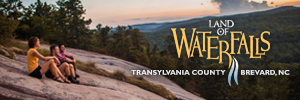WNC Mountain Biking Geography
Here we'll attempt to describe, in general, the mountains and trails of Western North Carolina.
Refer often to the WNC Area Road Map as you read on.
The Mountains of Western North Carolina
Asheville, NC, WNC's largest city (Pop. 2000 68,889) is located in the French Broad River valley, in the southern Appalachian mountains, the highest of the Appalachian chain. Although the peak elevations of the southern Appalachians aren't that impressive when compared to other world chains, they can be over 4,000 feet from base to top, and top out over 6,600 feet. Steep, rocky peaks are common as are trails that climb over 2000 feet.
<
p>Here are some major peaks and area elevations:
- City of Asheville - about 2200 feet.
- Town of Highlands - about 4500 feet.
- Town of Beech Mountain - about 5500 feet.
- Looking Glass Rock - 3969 feet (Davidson River Area)
- Mount Pisgah - 5721 feet (Pisgah Ranger District)
- Craggy Dome - 6085 feet (Great Craggy Mts. Area, near Craggy Gardens)
- Clingman's Dome - 6643 feet (highest in Great Smoky Mts. Area; highest in Tennessee on the NC-TN state line; 2nd highest in east)
- Mount Mitchell - 6684 feet - (highest point east of the Mississippi River, in the Black Mountain range)
- Highest Mountain Biking trails - Ivestor Gap Trail & Flat Laurel Creek Trail at the Black Balsam Parking Area--5840 feet
<
h2 class="largeHeading">Physically Speaking: The Trails of Western North Carolina
The trails in our area have various and even predictable characteristics, yet each one holds its own surprises. For example, trails that follow old road or railroad beds all have similarities, and you can learn what to expect from a trail that follows a ridgeline, one that travels beside a stream, or one that travels along a mountainside. Even the type of forest a trail travels through indicates what you might find along the way. But the view you'll find around the next bend--that can never be predicted by looking at a map.
Most trails are hatched through thick vegetation of many kinds, depending on their location. You can expect trails that follow rivers and creeks, and that travel through coves, to have a wet, muddy, rocky, and maybe sandy surface. These trails will pass through ferns and other lush groundcover, tall hemlocks, cove hardwood forests (tuliptree is acommon species), and thick Rosebay rhododendron, which blooms around June. Mountainside trails often follow old logging or skid road beds, which have now become singletrack, in forests of oaks, some cove hardwoods, and scattered mountain laurel and rhododendrons. Ridgetop trails are often dry and rocky, passing through laurel, Catawba rhododendron, and mixed hardwoods and pines. All trails can have rocks and roots.
Steep trail sections often have waterbars (logs) placed across the trails to keep erosion down. Many times though, the trails do erode and become shallow clay canyons. High elevation trails (rare) above 5000 feet are usually extremely wet or extremely dry andvery rocky, with twisted northern hardwoods, lush heath shrubs (rhododendron, mountain laurel, and blueberry), and some scattered spruces and firs.
Other trail features include likely stream crossings and a wide variety of vegetation on any trail, wildlife (birds, bears, and deer are common), large rock outcroppings and boulders,open man-made meadows with tall grass (unless you are lucky enough and it has just been cut), lots of doubletrack and forest roads, and active logging areas.


